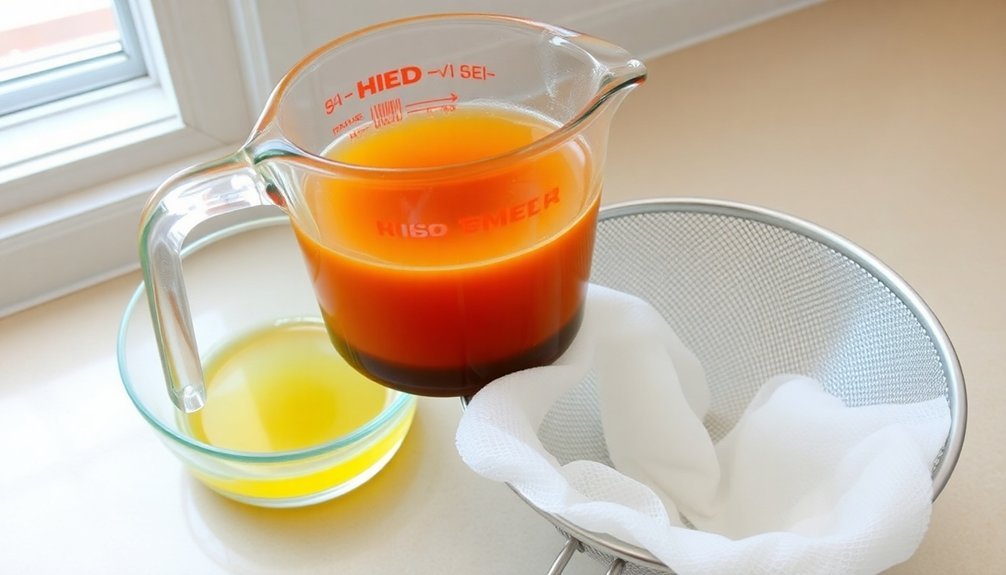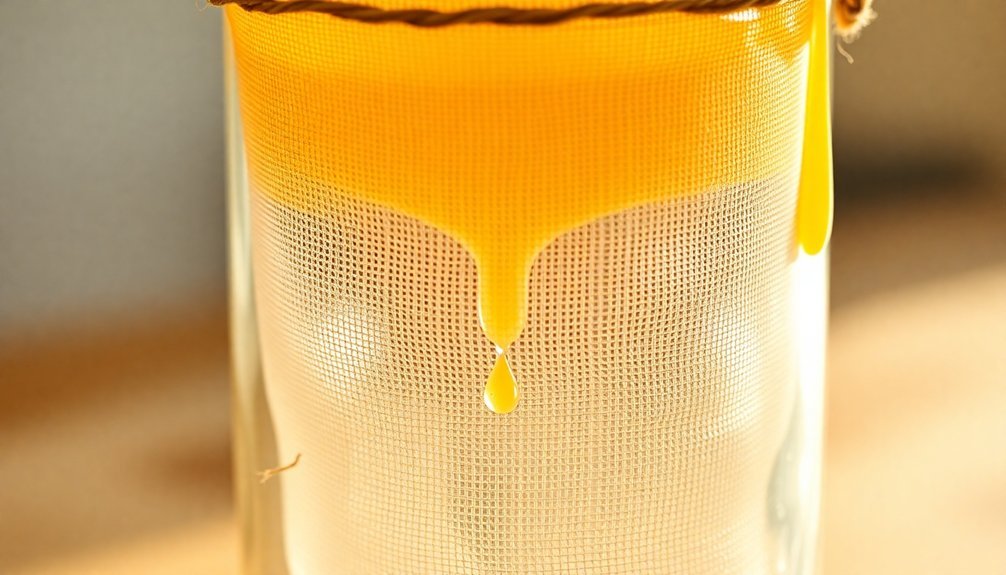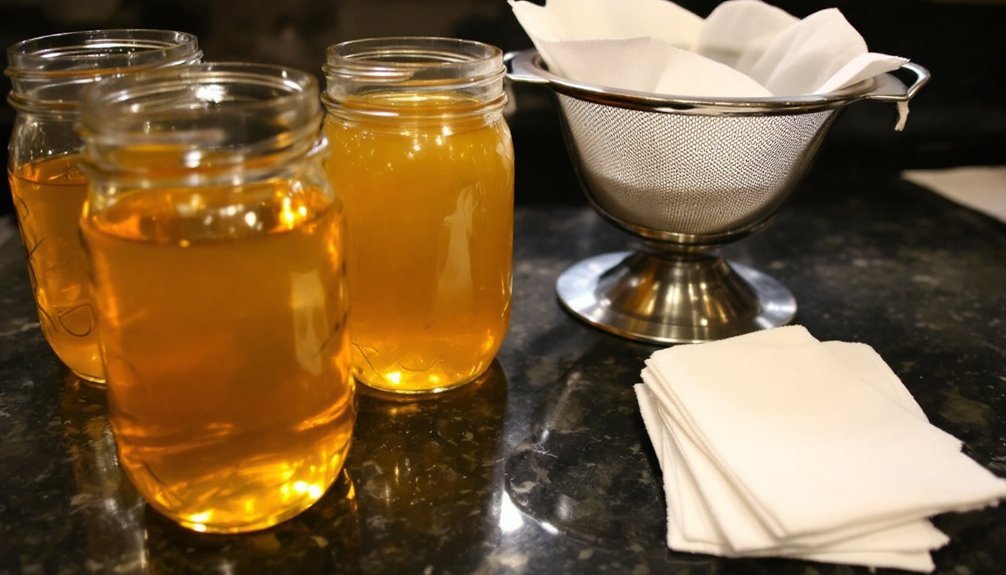You'll find several effective methods to filter rendered fat for clean results. Start with basic cheesecloth straining, try water clarification, or use a double-mesh sieve system for thorough filtering. The cold-settling process and muslin bag method offer eco-friendly options, while salt-water purification and multi-layer paper filtering provide extra purity. Each technique brings unique benefits, and exploring these methods will help you achieve the cleanest possible rendered fat for your cooking needs.
Basic Cheesecloth Straining Method

Using a basic cheesecloth straining method is one of the most reliable ways to filter rendered fat for a cleaner, purer final product.
You'll want to start by layering your cheesecloth over a fine-mesh sieve or strainer, securing it firmly with a rubber band to prevent any shifting while you pour.
Pour your rendered fat through the cheesecloth while it's still a hot liquid – this is essential for catching impurities effectively and preventing them from resolidifying in your filtered fat.
Pour rendered fat while hot to ensure optimal filtering – letting it cool first allows impurities to solidify and slip through.
For best clarity, you can use multiple layers of cheesecloth or strain the fat twice. This filtering process efficiently captures fine particles that might otherwise cloud your clean final product.
If you don't have cheesecloth on hand, paper towels can work as an alternative, but handle them carefully to avoid tears.
Water Clarification Technique

The water clarification technique offers a highly effective way to purify rendered fat through a simple separation process.
You'll need to add water to your rendered fat using a ratio of 1 quart of water per pound of fat. When you boil this mixture, the impurities naturally separate as the fat rises while contaminants sink to the bottom.
Let the mixture cool completely, and you'll find a solid layer of pure fat forms on top that you can easily remove.
For even better results, you can re-melt this fat layer with fresh water and salt, then strain it through cheesecloth. This additional step helps capture any remaining fine particles suspended in the fat.
The water clarification technique proves especially useful because it binds and removes impurities that might otherwise be difficult to filter out.
Double-Mesh Sieve System

Set up your double-mesh sieve system by stacking a coarse-mesh strainer on top of a fine-mesh strainer, and position them securely over a heat-safe container.
You'll want to filter your rendered fat while it's still warm (around 150-170°F) to maintain ideal flow through both layers, but not so hot that it's unsafe to handle.
Pour the fat slowly through the layered system, allowing the coarse mesh to catch larger particles first before the fine mesh captures remaining sediment.
Consider adding a layer of cheesecloth between the sieves for ultimate clarity.
Equipment Setup Instructions
Preparing a double-mesh sieve system starts with positioning a fine-mesh strainer securely over a deep bowl.
You'll need to line the strainer with cheesecloth or muslin, securing it firmly with a rubber band to prevent any movement during the filtering process.
For best results, set up a second fine-mesh strainer to catch any remaining impurities that might pass through the first layer.
When you're ready to filter your rendered fat, pour it through while it's still hot and liquid – this guarantees better separation of unwanted particles.
Don't forget to maintain your equipment by cleaning it thoroughly after each use to prevent cross-contamination in future batches.
Your double-mesh sieve system will work most effectively when you keep all components clean and properly secured throughout the filtering process.
Layered Filtering Technique
Once you've set up your double-mesh sieve system, implementing the layered filtering technique guarantees ideal separation of impurities from your rendered fat.
Begin by pouring your hot rendered fat through the coarse mesh strainer, which catches larger particles while maintaining smooth flow. Next, direct the filtered fat through your fine-mesh sieve to capture smaller impurities that passed through the first layer.
You'll find this layered filtering technique particularly effective when you use heat and gravity to your advantage. Keep the fat warm as it flows through both sieves to prevent premature solidification.
For maximum purity, you can repeat the filtering process, which will yield an exceptionally clean product suitable for both culinary applications and skincare applications.
The double-mesh sieve system assures you'll achieve professional-grade results every time.
Optimal Temperature Control
While straining rendered fat through a double-mesh sieve system, maintaining precise temperature control is essential for ideal results.
You'll want to monitor temperature consistently throughout the rendering process to prevent burning while ensuring impurities settle properly for maximum filtration.
Set up your fine-mesh strainer with cheesecloth when the fat is still hot and liquid, as this will make straining more efficient.
You'll find that contaminants separate more effectively at higher temperatures, but you'll need to keep the heat low enough to avoid scorching.
Try adding a small pinch of salt to help bind unwanted particles, making them easier to catch in your double-mesh system.
Remember to stir gently while monitoring temperature – this simple step maintains the quality of your rendered fat and results in a clearer final product.
Cold-Settling Separation Process

You'll notice distinct layers forming as your rendered fat cools down, with the pure white fat solidifying at the top and impurities settling at the bottom.
Once your fat has chilled overnight in the refrigerator, you can easily separate the clean, solidified layer from any remaining liquid or sediment below.
The cold-settling method lets you achieve crystal-clear results, and you can repeat the process multiple times until you're satisfied with the fat's purity.
Fat Layers and Temperature
After rendering fat, the cold-settling separation process offers a reliable method for achieving crystal-clear results.
When you allow rendered fat to cool, you'll notice distinct layers forming as the fat solidification occurs. The cooling process naturally separates impurities, making clean extraction easier with minimal effort.
For ideal clarity during cold-settling, follow these temperature-based steps:
- Let the rendered fat cool completely at low temperature, allowing the solid fat layer to form on top.
- Watch for impurities settling at the bottom, creating a clear separation between layers.
- Remove the solidified fat layer from the top, leaving behind any settled contaminants.
This natural separation method helps you achieve superior results without additional heating, preserving the fat's quality while ensuring unwanted particles remain at the bottom.
Draining Pure White Layers
The essential final step in cold-settling separation involves carefully removing the pure white layer of fat that forms at the top of your refrigerated container. After refrigerating your strained fat overnight, you'll notice a clean product with distinct layers. Lift the solidified top layer gently to avoid disturbing the settled impurities below.
| Process Step | Action | Result |
|---|---|---|
| Cooling | Refrigerate strained fat | Layers separate |
| Separation | Remove white top layer | Pure fat collected |
| Recovery | Reheat liquid portion | Additional fat extracted |
If you're not satisfied with the clarity, you can filter the rendered fat through the cold-settling process again. The remaining liquid beneath can be reheated and strained to extract more usable fat, while the sediment at the bottom should be discarded to guarantee ideal purity.
Muslin Bag Filtering Method

Muslin bags represent one of the most reliable and eco-friendly methods for filtering rendered fat. You'll find these reusable bags excellent at capturing impurities while allowing clean fat to pass through their fine weave. The straining process is straightforward and effective for achieving pure results.
Muslin's fine weave effectively filters impurities from rendered fat while offering an eco-friendly, reusable solution for achieving clean results.
To get the best filtration results with your muslin bag:
- Position the bag securely over a fine mesh strainer or bowl before pouring hot fat.
- Let the liquid drain completely, ensuring maximum yield while trapping solid particles.
- Clean your bag thoroughly with warm water after use to maintain its effectiveness.
You'll appreciate how these bags can be washed and reused multiple times, making them more sustainable than disposable alternatives.
Their durability and superior straining capabilities make them an essential tool for processing rendered fat.
Salt-Water Purification Steps
Salt-water purification offers three key advantages for achieving crystal-clear rendered fat.
You'll remove more impurities, enhance straining effectiveness, and improve the final product's clarity.
To begin the salt-water purification process, combine 3 tablespoons of salt with a quart of water and your rendered fat in a pot.
Keep the mixture at low heat until the fat liquefies, but don't let it boil.
Next, strain the liquid through a fine-mesh sieve or cheesecloth to catch larger particles.
Let the mixture cool completely.
You'll notice the solid fat floating on top of the water, while impurities settle at the bottom.
For the cleanest results, you can repeat the process by re-melting your solid fat with fresh salt water.
This double purification guarantees the purest rendered fat for storage.
Multi-Layer Paper Filter Technique
After mastering salt-water purification, you'll want to explore the multi-layer paper filter technique for even finer results. This advanced filtration process uses multiple layers of paper filters to catch smaller impurities that single layers might miss.
To effectively filter your rendered fat:
- Position a fine-mesh strainer over a bowl and line it with several layers of paper filters or towels.
- Pour the warm liquid fat through while it's still fluid to prevent solids from clogging.
- Add a layer of cheesecloth on top for enhanced purification process.
You'll find this method particularly effective because it captures tiny particles that would otherwise remain in your fat.
The combination of strainer, paper filters, and cheesecloth guarantees you'll get the cleanest possible result for storage or cooking use.
Frequently Asked Questions
How to Filter Rendered Fat?
Line a strainer with cheesecloth, pour your hot rendered fat through it, and let it drain. Add salt to help bind impurities, then strain a second time for extra clarity. You'll get cleaner results.
How to Pull Impurities Out of Tallow?
You'll need to strain your melted tallow through cheesecloth-lined strainers. Add salt while rendering, let it cool to separate impurities, then remelt with fresh water. Repeat this process for cleaner results.
What Is the Best Filter for Tallow?
You'll get the best results using a double-filtering method: line a fine-mesh strainer with cheesecloth and strain your hot tallow through both. This combination catches both large and small impurities effectively.
Can I Strain Fat Through a Coffee Filter?
Yes, you can strain fat through a coffee filter. It'll work well to catch fine particles, but be patient as it's a slow process. Let the fat cool slightly first to prevent filter damage.
In Summary
Now you're equipped with seven reliable methods to achieve crystal-clear rendered fat. Whether you choose the basic cheesecloth approach or opt for the more advanced water clarification technique, you'll get consistently clean results. Pick the method that fits your time and available tools. Remember, properly filtered fat will store longer and produce better results in all your cooking projects.





Leave a Reply